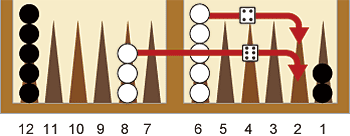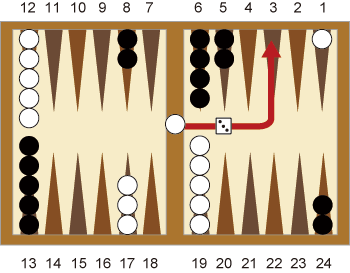How To Set Up Backgammon Table
Backgammon is one of the oldest lath games with origins dating as far back as 3000 BC. It is a game of luck and strategy and popular around the world. Easy to larn and fun to play, it is no wonder why it has withstood the test of fourth dimension and is played by so many people.
Equipment
The game is played by two players each, with fifteen checkers of his own colour.
Each player also has their own pair of dice and dice loving cup.
A doubling cube with the numbers 2, iv, viii, 16, 32, 64 is used for tracking the stakes of the circular.
The board consists of 24 long triangles called points or pips. The triangles alternate in color and are divided into four quadrants of vi triangles each. The four quadrants are the role player's home lath and outer board, and the opponent's dwelling house lath and outer board. The home boards and outer boards are separated by a divider down the middle referred to as the bar. The starting positions of the pieces are arranged as shown below.

The points are numbered starting at 24 in the opponent's home lath and ending at 1 in the player's own home board.
The objective of the game is to move all of 1's ain checkers to the home board and and so remove (conduct off) the pieces from the board entirely. The players move their checkers in opposing direction post-obit a horseshoe path every bit illustrated.


Gameplay
To showtime the game, each thespian rolls a unmarried die and the player with the college number moves beginning using both numbers rolled. If both players roll the same number, the dice are rolled once again until they roll dissimilar numbers. The players then alternate turns, rolling two dice at the showtime of each plow. The dice must ever be rolled together and land flat on the right hand side of the game lath. If it lands exterior or on a checker the dice must be rolled again.
Moving
-
The dice coil determines how many points the player is supposed to move its checker. The checker always moves forward following the horseshoe path towards the player'due south home board.
-
A signal that is not occupied by two or more opposing checkers is an open indicate. When moving a checker information technology may land only on an open up point.
-
The two die constitute two separate movements. For example, if a player rolls a 6 and a 4, he may move one checker 6 spaces to an open up point and some other checker four spaces to an open up indicate.

-
The player may likewise choose to move the aforementioned checker twice, every bit long as each motility is on to an open indicate.

-
When a double is rolled the numbers on the dice are played twice. For example, if a player rolls ii fives, he may motility his checkers v points, four times in any combination landing on open points.
-
A player must movement both numbers rolled if possible (four numbers if a double is rolled). If simply 1 of the numbers can be played because only one open point is bachelor, the histrion must play that number. If either number tin can exist played only not both, then the larger number must be played. If neither number tin be played then the player loses his turn. If a player cannot play all four numbers in the case of a double, the player must play as many numbers as possible.
Hitting
An open point containing 1 opposing checker is a blot . When a checker is moved onto a blot, the blot is striking, and the opposing checker that has been hit is placed on the bar.
When a player has ane or more checkers on the bar he must beginning re-enter them onto the opponent's home lath. A checker enters past rolling two dice and moving it to the respective signal of 1 of the numbers on the opponent'due south abode board.

If the checker(south) on the bar cannot enter into an open bespeak, the player loses his plough and the checker(south) remains on the bar. A thespian cannot motility any other slice until all his checkers are off the bar. If a player is able to enter some only not all of his checkers off the bar, his plough is finished. If a player's checker(s) have been moved off the bar, any unused number must be played.
Bearing Off
When all of a player's checkers are in his abode board, he can brainstorm a process of removing them called bearing off. This is done past rolling a number corresponding to a indicate with a checker residing on it.
If no checker can acquit off with the number(s) rolled, the player must brand a legal motion(s) with a checker(s) from a higher point.

If there are no checkers on higher number points, and then the thespian bears off with a checker from the next highest point.

Doubling
A doubling cube is used to increase the stakes at any betoken in the game. At the start of the game, the doubling cube is placed on the bar with 64 facing upwards. Before the whorl on a histrion'due south plough, that player may propose to double the current stakes. The opponent either accepts (takes) the doubled stakes or resigns (drops) and loses the match and the current stakes. If the opponent takes he becomes the owner of the cube and the cube is turned over then that 2 is facing up. Thereafter only the owner of the cube has the right to suggest to double the stakes again (redouble). If the opponent takes, the ownership of the cube is passed over to him and this process tin can go on on from 4 to 8 and onwards. At that place are no limits to redoubles fifty-fifty though the highest number on the cube is 64.
Gammon and Backgammon
At the end of the game, if a person has borne off all fifteen of his checkers and the opponent has borne off at to the lowest degree ane checker, that person wins the current pale. If the opponent has not borne off any checkers, so the opponent loses a gammon and loses double the current stakes. If the opponent has non borne off any checkers and nevertheless has one or more checkers on the bar, the opponent loses a backgammon and loses triple the current stakes.
Shop for a Backgammon Set
© 2022 Yellow Mountain Imports, Inc.
Source: https://www.ymimports.com/pages/how-to-play-backgammon

0 Response to "How To Set Up Backgammon Table"
Post a Comment